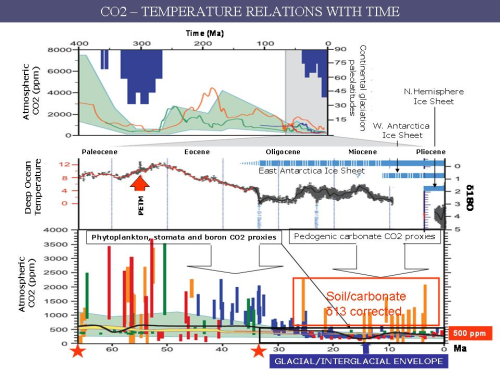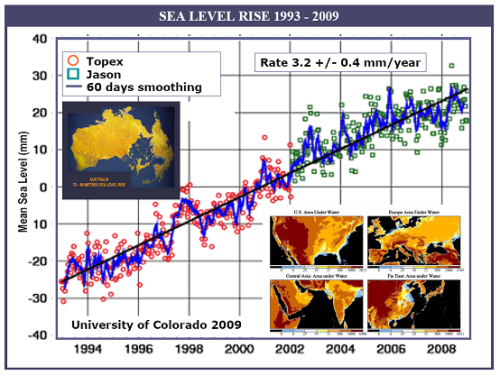The present state of the biosphere, allowing survival of large mammals and of humans on the continents, developed when CO2 levels fell below about 500ppm some 34 million years ago (end Eocene). At this stage, as well as following warm periods in the Oligocene (about 25 million years ago) and mid-Miocene (about 15 million years ago), development of the Antarctic ice sheet led to a fundamental change in the global climate regime. About 2.8 million years ago (mid-Pliocene) the Greenland ice sheet and the Arctic Sea ice began to form, with further decline in global temperatures expressed through glacial-interglacial cycles regulated by orbital forcing (Milankovic cycles), with atmospheric CO2 levels oscillating between 180 and 280ppm CO2 (Figure 3). These conditions allowed the emergence of humans in Africa and their migration all over the world.
Recent paleoclimate studies, using multiple proxies (soil carbonate δ13C, alkenones, boron/calcium, stomata leaf pores), indicate that the current CO2 level of 388ppm and CO2-equivalent level of 460ppm (which includes the methane factor), commit warming above pre-industrial levels to 3 to 4 degrees C in the tropics and 10 degrees C in polar regions, tracking towards an ice-free Earth.
Small human clans post-3 million years-ago responded to changing climates through migration within and out of Africa. Homo sapiens emerged during the glacial period preceding the 124,000 years-old Emian interglacial, when temperatures rose by about 1 degree C and sea levels by 6-8 metres relative to pre-industrial. The development of agriculture and thereby human civilization had to wait until climate stabilised about 8,000 years ago, when large scale irrigation along the great river valleys (the Nile, Euphrates, Hindus and Yellow River) became possible.
Advertisement
Since the 18th century mean global temperature has risen by about 0.8 degrees C. Another 0.5 degrees C is masked by industrial-emitted aerosols (SO2), and further rise ensues from current melting of the ice sheets and sea ice. The polar regions, acting as the “thermostats” of the Earth, are the source of the cold air current vortices and the cold ocean currents, such as the Humboldt and California current, which keep the Earth’s overall temperature balance, much as the blood stream regulates the body’s temperature and the supply of oxygen.
At 4 degrees Celsius advanced to total melting of the Greenland and Antarctic ice sheets leads to sea levels tens of metres higher than at present. Further rise of CO2-e above 500ppm and mean global temperatures above 4 degrees C can only lead towards greenhouse Earth conditions such as existed during the Cretaceous and early Cainozoic (Figure 3).

Figure 3. CO2 and deep ocean temperature changes during the Cainozoic (since 65 million years-ago [Ma]), based on proxy studies (stomata fossil leaf pore densities; 13C isotopes in carbonate nodules in fossil soil), indicating the onset age of the Antarctic ice sheet (c. 34 Ma), West Antarctic ice sheet and Northern Hemisphere ice sheets (c. 3 Ma). Note the glacial-interglacial approximate upper limits at 500ppm CO2.
A rise of atmospheric CO2 concentration triggers feedback effects due to warming, desiccation and burning of vegetation, releasing more CO2. The onset of methane release from polar bogs and sediments is of major concern. Ice/melt water interaction proceeds as melt water melts more ice, ice loss results in albedo loss and exposed water absorb infrared heat, resulting in an amplified feedback cycle. Because CO2 is cumulative, with atmospheric residence time on the scale of centuries to millennia, stabilisation of the climate through small incremental reduction in emissions may not be sufficient to avoid runaway climate change and possible tipping points.
Advertisement
Climate change is appropriately described as a global oxygenation event affecting geological carbon deposits as well as the present biosphere. At 2ppm/year the pace of carbon oxidation exceeds the highest recorded geological rate of 0.4ppm/year at the Paleocene-Eocene boundary at 55 Ma, when about 2000GtC were burnt, triggering an extinction of species.
Sea level rise constitutes a critical parameter which reflects all other components of climate change. Since the early 20th century the rate of sea level rise increased from about 1mm/year to about 3.5mm/year (1993 - 2009 mean rate 3.2+/-0.4mm/year), representing a nearly four-fold increase since the onset of the industrial age (Figure 4).

Discuss in our Forums
See what other readers are saying about this article!
Click here to read & post comments.
55 posts so far.